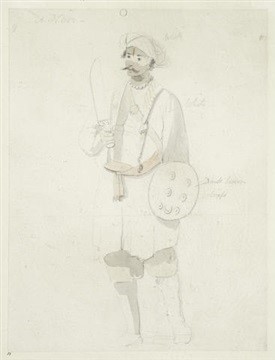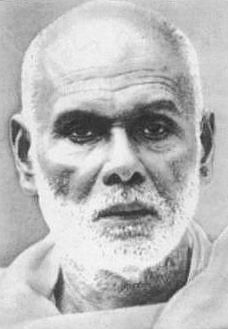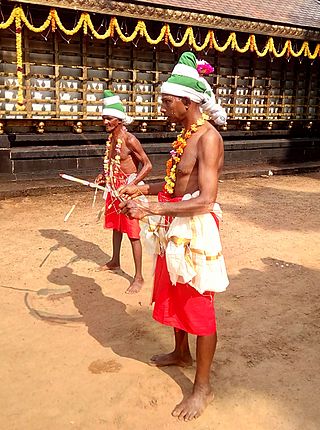
Changanassery, also spelt Changanacherry, is a municipality in Kottayam district in Kerala, India. It is also the headquarters of the Changanassery Taluk. The town is spread over an area of 14.3 km2 (5.5 sq mi) and has a population of 47,685. Changanassery is located 17 km (11 mi) south of the district headquarters Kottayam and 117 km (73 mi) north of the state capital Thiruvananthapuram.
Pillai or Pillay, meaning "Child of King" (Prince) or "Child", is a surname found among the Malayalam and Tamil-speaking people of India and Sri Lanka.

The Nair also known as Nayar, are a group of Indian Hindu castes, described by anthropologist Kathleen Gough as "not a unitary group but a named category of castes". The Nair include several castes and many subdivisions, not all of whom historically bore the name 'Nair'. These people lived, and continue to live, in the area which is now the Indian state of Kerala. Their internal caste behaviours and systems are markedly different between the people in the northern and southern sections of the area, although there is not very much reliable information on those inhabiting the north.

Koyapalli Kelappan was an Indian politician, independence activist, educationist and journalist. During the Indian independence movement, he was the lead figure of Indian National Congress in Kerala and was popularly known as Kerala Gandhi. After Indian independence, he held various seats in Gandhian organisations. He was the co-founder and the first president of the Nair Service Society and was also the founder of Kerala Kshetra Samrakshana Samiti.

Mannathu Padmanabhan was an Indian social reformer and freedom fighter from the south-western state of Kerala. He is recognised as the founder of the Nair Service Society (NSS), which represents the Nair community that constitutes 15.5% of the population of the state. His birthday(January 2) is observed as Mannam Jayanti every year. Padmanabhan is considered as a visionary reformer who organised the Nair community under the NSS.

Govindan Parameswaran Pillai, also known as Barrister G. P. Pillai, was a freedom fighter, social reformer, barrister, journalist, and publisher. He established the first English language newspaper in South India, The Madras Standard. He drafted the Malayali Memorial in 1891. Pillai is the only Malayali whom Mahatma Gandhi has mentioned in his autobiography. He regularly wrote columns in various newspapers. Pillai stood against autocratic governance in Travancore and promoted civil rights and equal opportunity among all classes.

The Nambudiri, also transliterated as Nampoothiri, Nambūdiri, Namboodiri, Namboothiri and Nampūtiri, are a Malayali Brahmin caste, native to what is now the state of Kerala, India, where they constituted part of the traditional feudal elite. Headed by the Azhvanchery Thamprakkal Samrāṭ, the Nambudiris were the highest ranking caste in Kerala. They owned a large portion of the land in the region of Malabar, and together with the Nair monarchs, the Nambudiris formed the landed aristocracy known as the Jenmimar, until the Kerala Land Reforms starting in 1957. Naturalized Tulu Brahmins who took up Nambudiri customary ways are known as Embranthiri Brahmins.

Guruvayur Satyagraha took place in 1931–32 and was a Satyagraha in the present-day Thrissur district, which was then part of Ponnani Taluk of Malabar district, now part of Kerala, India. It was an effort to allow entry for Marginalised communities into the Guruvayur Temple.

The Nair Brigade was the army of the erstwhile kingdom of Travancore in India. Nairs were a warrior community of the region. The personal bodyguard of the king Marthanda Varma (1706–1758) was also called Thiruvithamkoor Nair Pattalam. The Travancore army was officially referred as the Travancore Nair Brigade in 1818.

The Ezhavas are a community with origins in the region of India presently known as Kerala, where in the 2010s they constituted about 23% of the population and were reported to be the largest Hindu community. The Malabar Ezhava group have claimed a higher ranking in the Hindu caste system than do the others, although from the perspective of the colonial and subsequent administrations they were treated as being of similar rank.

Thattayil is a village near Pandalam in the Pathanamthitta district, state of Kerala, India.

Government Law College, Thiruvananthapuram also known as GLC Trivandrum, is an institution for legal education at graduate and post-graduate levels in Kerala, India. Established by the then Maharaja of the state of Travancore in 1875, it is one of the oldest law colleges in India, and is affiliated to the University of Kerala. Alumni of the college consists of judges of the Supreme Court of India including Justice Fathima Beevi, judges of various High Courts, statesmen and noted academicians like N. R. Madhava Menon.
K. P. Karunakara Menon (1930–2002) was the president of Nair Service Society till his death in 2002. He was succeeded by Sri. P. V. Neelakanta Pillai. Menon, who hailed from Thrissur was one of the few Nair outside Travancore to become the president of NSS. He is best remembered for his fierce stand against the reservations and affirmative quotas for lower castes in the educational institutions of Kerala.
Madampi(equivalent to Lord in English) is an aristocratic title given to the uppermost subdivisions of Nairs in Kerala, by the Maharajahs of Travancore and Cochin. Usually, it was given in addition to the Pillai title. Madampis served as Jenmis or landlords during the pre-independence era. Their power was severely reduced after the Communist government passed the Land Reforms Ordinance. The title Madampi was also used in Cochin, to denote the 71 Nayar chiefs who ruled under the Maharajah of Cochin. A few Nambuthiri landlord families, most notable of whom being those in Vanjipuzha and Makilanjeri, were also given the Madampi title. In Cochin, the Madampis had their own armies, but seldom numbered more than 100. Their power was only a little bit higher than that of the Desavazhis. Madampis supplied chieftains along with soldiers in times of war to the King.

Pillai, meaning Prince, is a title of nobility which can either refer to a ruling chief, members of the nobility, or junior princes of the royal family historically ranked immediately below the king. The oldest lineages of Pillais include not only Kshatriyas but also brahmins who took up the sword. From the early modern period, the title also came to be bestowed upon Savarna subjects by the Kings for services military or political, most of whom were of Nair origin.

NSS Hindu College, Changanassery is one of the oldest and largest institutions of higher education of Nair Service Society (NSS) was established in 1947 by Indian social reformer and freedom fighter Sri. Bharatha Kesari Mannathu Padmanabhan and is located on par with NSS Central Headquarters at Perunna, Changanassery. It is one of the sixteen Arts and Science colleges under the NSS and is the very first in terms of establishment. The college is affiliated to Mahatma Gandhi University, Kerala and is re-accredited by National Assessment and Accreditation Council (NAAC), an autonomous body of UGC with "A" grade. Its academics is a conglomerate of 14 Undergraduate, 11 Postgraduate and 10 Doctoral programmes over various disciplines of Arts, Science and Commerce.

K. Kumar (1894–1973) was an Indian orator, reformer and writer of the Indian pre-independence era. He was one of the earliest socio-political leaders to have brought Gandhi's message and the spirit of the national movement to the erstwhile Travancore State. A gifted translator, he traveled with Gandhi during his Kerala tours, interpreting his English speeches in Malayalam. He was also an Advisor to the Nehru government. Kumarji was the President of the Travancore Congress Committee and was also in charge of Gandhiji's Travancore tour more than once. He served on the AICC and on the working committee of the AICC, TC-PCC/ KPCC heading its Constructive Work Committee during crucial years of the freedom movement. He also functioned as the Chairman of the Parliamentary Committee of Travancore

M. R. Ry. Chempakaraman Padmanabhan Kesava Pillai of Kandamath, Pillai of Kandamath (1830–1924), was an Indian Zamindar, one of the jenmis of Travancore and a member of the Sree Moolam Popular Assembly.

















